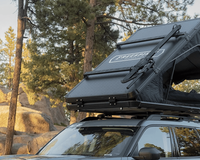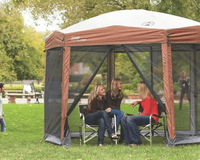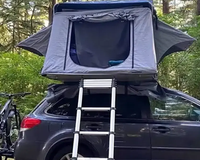Among the most essential gear for any backpacker is a tent, providing shelter and protection from the elements. Knowing how to carry a tent while hiking efficiently is crucial to ensure a comfortable and enjoyable trip..In this comprehensive guide, we will walk you through step-by-step instructions on how to pack a tent into a backpack, explore the option of carrying it outside the backpack, and offer valuable tips to ensure a successful and organized camping trip.

How to Pack a Tent into a Backpack?

Packing a tent into a backpack may seem challenging at first, but with a bit of practice and organization, you can master this essential skill for any backpacking adventure.
- Select the Right Backpack: Before you start packing your tent, ensure you have the right tent backpack for the job. An internal frame backpack is recommended, as it provides ample space and support for carrying your tent and other gear. Make sure the backpack's size is suitable for your tent's dimensions and your hiking needs.
- Prepare the Tent: Before packing your tent, ensure it is completely dry. If it's wet or damp, set it up in an open area with good ventilation and sunlight to air-dry. Packing a wet tent can add unnecessary weight and cause mildew, making it uncomfortable during your trip.
- Roll Up the Tent: Lay out your tent on a flat surface, making sure all zippers and doors are closed. Start rolling up the tent tightly from one end to the other, ensuring it stays in a straight line. Keep the tent poles in their designated bag and place them alongside the rolled tent. If your tent comes with a rain fly and stakes, add them to the roll as well.
- Place Tent in its Stuff Sack: Once the tent is tightly rolled, gently stuff it into its designated stuff sack. Some tents may have compression straps or buckles to secure the roll further. Ensure the tent is packed as tightly as possible to save space inside the backpack.
- Positioning the Tent in the Backpack: Now that your tent is packed, it's time to position it in your backpack. Open the main compartment of your backpack and find the core zone, which is the central area close to your back. Place the tent at the bottom of the core zone to create a stable and balanced weight distribution.
- Add Other Gear: With the tent in place, add the rest of your gear to the backpack. Start with heavier items, such as your sleeping bag, at the very bottom, on top of the tent. This creates a cushioning effect and keeps the heavier items closer to your center of gravity for better balance.
- Organize and Secure: As you add more gear, make sure to distribute the weight evenly, with lighter items placed towards the top of the backpack. Use the internal compartments and pockets of the backpack for tent to keep your gear organized and easily accessible. Secure items with compression straps or buckle them in place to prevent shifting during the hike.
- Tent Poles and Rain Fly: If you choose to keep the tent poles inside the backpack, tuck them vertically along the sides to prevent poking or discomfort. Alternatively, if your backpack has designated straps or pockets for carrying tent poles externally, secure them carefully.
- Final Check: Before hitting the trail, do a final check to ensure everything is packed securely and comfortably. Adjust the straps of your backpack to fit snugly and evenly distribute the weight. Walk around with your loaded backpack to test the comfort and make any necessary adjustments.
By selecting the right backpack, rolling the tent tightly, and positioning it correctly, you'll have a comfortable and hassle-free camping experience amidst the great outdoors.
Can You Pack a Tent outside a Backpack?

Yes, it is possible to pack tents outside backpacks, and some hikers prefer this method under certain circumstances. However, there are both advantages and disadvantages to consider when deciding whether to carry your tent externally.
Advantages of Packing a Tent outside a Backpack:
- Extra Space: By strapping the tent to the outside, you free up valuable space inside your backpack for other gear and essentials.
- Quick Access: Having the tent outside allows for easy access during the day. If you encounter sudden rain or need a sheltered break, you can quickly set up the tent without unpacking your entire backpack.
- Wet or Dirty Tent: If your tent is wet or covered in mud after use, packing it outside prevents the dampness from transferring to the rest of your gear inside the backpack.
- Larger Tent with Smaller Backpack: If you have a larger tent and a smaller backpack, it may not fit inside the pack comfortably, making external packing a viable option.
Disadvantages of Packing a Tent outside a Backpack:
- Risk of Damage: When strapped to the outside, the tent is exposed to potential damage from branches, rocks, or other hazards along the trail.
- Weight Distribution: Carrying the tent externally can throw off the weight distribution, leading to an imbalance that might affect your posture and hiking comfort.
- Snagging Hazard: The tent and its components, such as poles or guylines, may snag on branches or brush, causing inconvenience and potential damage.
- Limited Protection: An external tent is more exposed to the elements, especially heavy rain, increasing the risk of getting wet and reducing the tent's overall lifespan.
To pack a tent outside your backpack, use designated straps or compression systems that secure the tent tightly to the backpack. Ensure that all components of the tent, including the rainfly, poles, and stakes, are well-attached and won't come loose during your hike.
Ultimately, the decision to pack a camping tent outside or inside a backpack depends on personal preference, the size of the tent and backpack, the weather conditions, and the specific requirements of your hiking trip. If you choose to carry the tent externally, be mindful of potential risks and take extra precautions to protect your gear.
How to Pack Tent Smaller?
To pack a tent smaller, use compression sacks or stuff sacks designed for tents to remove excess air and compress the tent tightly. Consider packing the components separately, removing poles and stakes from their storage bags, and using external attachment points or gear loops on your backpack to secure the tent components outside. Practice packing techniques to find the most efficient method for reducing its size. Ultralight options like tarps or minimalist shelters can also be considered for a more compact and lightweight packing solution.
Other Tips When Packing a Tent into a Backpack

When packing a tent into a backpack for your hiking or camping trip, there are several additional tips and best practices to keep in mind to ensure a smooth and efficient packing process. Here are some valuable tips to consider:
- Use a Ground Cloth or Footprint: To protect the tent floor from punctures and abrasions, use a ground cloth or footprint. Some tents come with a purpose-built footprint that fits perfectly under the tent. If your tent doesn't have one, consider using a lightweight tarp or groundsheet cut to the size of the tent's floor.
- Organize Components: Keep all tent components together and well-organized. Pack the tent, rainfly, poles, and stakes in their respective stuff sacks or sleeves. This ensures that you can quickly access everything you need when setting up or taking down the tent.
- Pack Poles Securely: If you choose to carry tent poles inside the backpack, ensure they are securely fastened and won't shift during the hike. Some backpacks have designated pockets or straps to hold tent poles in place. Alternatively, you can bundle them together with the tent or sleeping bag using compression straps.
- Utilize Internal Pockets and Compartments: Many modern backpacks come with internal pockets and compartments. Use these to your advantage to keep smaller items organized and easily accessible. Items like headlamps, compasses, maps, or trail snacks can be stored in these pockets for convenience.
- Pack Heavier Items Lower: To maintain better balance and stability, place heavier items closer to your back and lower in the backpack. This positioning helps distribute the weight evenly and prevents the backpack from pulling you backward.
- Protect Fragile Items: If you carry fragile items, such as camera equipment or glass containers, ensure they are packed securely and surrounded by soft items like clothing or sleeping pads to cushion them from impacts.
- Consider Splitting Gear: If hiking with a partner, consider splitting the tent and its components between the two backpacks. One person can carry the tent body, while the other carries the rainfly and poles. This distributes the weight more evenly.
- Practice Packing: Before embarking on your hike, practice packing your backpack at home to find the most efficient and comfortable arrangement. This allows you to make adjustments and ensures that everything fits properly.
By following these tips and organizing your gear thoughtfully, you can pack your tent and other equipment in a way that maximizes space, maintains balance, and makes your hiking or camping experience more enjoyable.
Final Thoughts
Properly getting a tent fit in backpack is a skill that can enhance your backpacking experience. Ensure your tent is dry, roll it tightly, and position it correctly inside your backpack for better weight distribution. While carrying a tent outside the backpack is an option, it comes with its own set of risks, and packing it inside the backpack is generally safer.


















